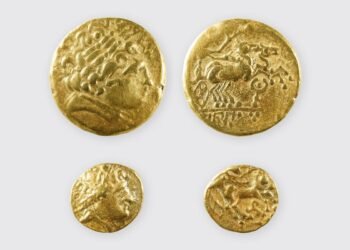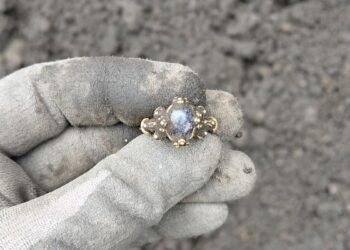Archaeologists in Poland have uncovered a unique and elegantly crafted jewel from the moat of the medieval Castle Kolno, once situated along a ducal border. The silver setting, adorned with a vibrant amethyst and finished with fire gilding, likely belonged to a knight or noble and might have been used as a decorative accessory or a brooch.

“This makes it especially unique in a medieval settlement context,” said Lech Marek, an archaeologist at the University of Wrocław, to Live Science. “I believe the item was originally part of a brooch or, less likely, a coronet or a crown.”
The jewel, dated to be more than 600 years old, was found in the moat sediments between timber bridge posts at the castle’s northern approach. Excavation work on Castle Kolno began in 2010, led by Marek. Since then, the team has recovered military gear of the 14th and 15th centuries, equestrian items, and ceramics. But this jewel is outstanding for its context and craftsmanship.
Though medieval jewelry is normally found in tombs or hoards, its appearance in a mundane, travel-related setting is rare. Castle Kolno, which was originally built in the early 13th century by Duke Bolesław III of Brzeg, later housed wealthy knights before being destroyed in 1443 during civil conflict in Silesia.

Using Raman spectroscopy, the stone was confirmed to be amethyst, and X-ray fluorescence revealed the metal was fire-gilded silver with mercury—a poisonous but common medieval technique for giving a golden shine to silver.
Marek said that because of their symbolic significance, availability, and beauty, amethysts were popular during the Middle Ages. In a paper co-authored with archaeologist Beata Miazga and published in Antiquity, they described how amethysts were believed to have supernatural powers. Medieval folklore claimed that the amethyst guarded against intoxication and venom. They also symbolized faith, modesty, and martyrdom.
Marek emphasized that the symbolism of jewelry played a significant role in medieval society.
Such luxury objects are viewed by archaeologists as markers of “conspicuous consumption”—objects that are more than functional and serve as symbols of status and wealth. Regarding the Kolno jewel, being lost in routine travel gives rise to a poignant human element: a momentary lapse that preserved a high-status object for six centuries.
Though the true owner of the original piece remains a mystery, experts agree that it must have been owned by an aristocrat. The recovery is a tangible and rare link to the material culture—and social values—of medieval nobles.






















Disclaimer: This website is a science-focused magazine that welcomes both academic and non-academic audiences. Comments are written by users and may include personal opinions or unverified claims. They do not necessarily reflect the views of our editorial team or rely on scientific evidence.
Comment Policy: We kindly ask all commenters to engage respectfully. Comments that contain offensive, insulting, degrading, discriminatory, or racist content will be automatically removed.
In a deleted article it said it was a ring, had different angels, and its so large it would it fit a man 12 ft tall
Wow!
It’s more likely a Catholic bishop’s, or higher rank, as gold and amethyst rings were a required part of their regalia at the time. Aristocratic origin would be consistent as higher offices were purchased by / awarded to younger sons of the noble wealthy, which would also explain why cost was cut by using gilding. Also, the more powerful residents were, the higher the clerical rank attending them. This was during the late Crusades so it could have belonged to a warrior priest. Poland was known as a strong Catholic bastion until recent Soviet activities.
Love you